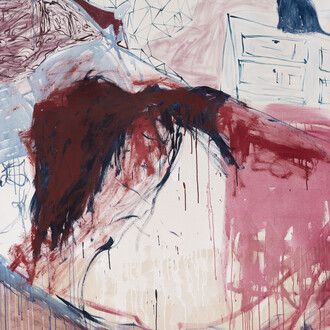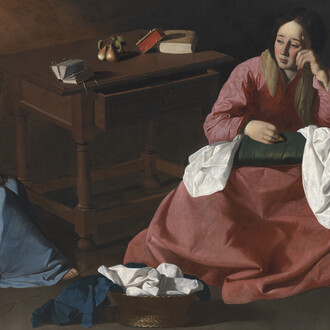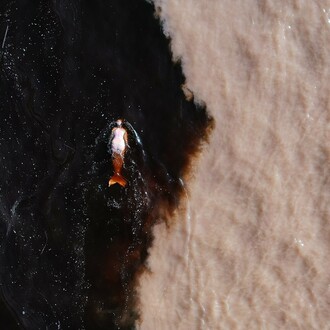Opera Gallery is pleased to present The library, a solo exhibition of paintings and sculptures by pioneering Spanish artist Manolo Valdés. Renowned for his paintings, sculptures and multimedia works that reference and re-contextualise important moments from the art historical canon through a lens that ranges from reverential to humorous and ironic. Comprised of paintings and new mixed media sculptures, The library explores Valdés’ oeuvre as a library that combines classical references with modern aesthetics.
Central to the exhibition are monumental works from Valdés ongoing Librería series. These works include large-scale carved wood reproductions of shelves replete with books, serving as both a visual symbol for intellectual exploration and an apt analogy for memory through its pieced together, embedded fragments. Using a crowded bookshelf as a central motif, Valdés makes a veiled reference to the pursuit of knowledge and exploration of cultural heritage that appears in his own practice.
In the Librería series, Valdés’ continues to interrogate his own research and art-making process while exploring the changing nature of transferred generational knowledge and the materiality of books and printed matter within the digital age. Each nameless book in the series represents a bridge between the past and future of painting and sculpture, and the exchange of ideas along the way. Notably, the series can also be seen as a tribute to the still life genre through the mechanics of abstraction. Within this context, the Librería sculptures come to represent the canon of art as an ever-expanding resource for the creation and interpretation of culture.
Surrounding these bookcases are works that allude to some of Valdés’ reference points; Diego Velázquez’s Las meninas (1656) and Henri Matisse’s Femme au chapeau (1905) chief among them. Both of these paintings constitute historical moments and, in borrowing their figures, faces and forms, Valdés creates new iterations in materials including crystalline resin, oil paint, burlap and bronze. These interpretations of allegorical characters and totemic icons invites the viewer to consider the subject matter within the context of the present and future - demonstrating the Spanish polymath’s enduring interest in themes of repetition and proliferation.
In a monumental new bronze sculpture, Valdés simulates the materiality of deconstructed cardboard boxes intricately reassembled into the form of one of his iconic Infanta Margarita figures, an homage to the central figure in Velázquez’s Las meninas. Similarly, Personaje con turbante rojo reimagines the central figure from Matisse’s Femme au chapeau in a new composition with mixed media.
The mariposa (or ‘butterfly’ in Spanish) is another recurring motif in Valdés oeuvre. In his sculptural busts, winged insects often appear together as a clustered, swirling headdress atop a static head, thematically representing the inception of ideas and their origins.
“Manolo Valdés is an artist whose work resonates far beyond the edges of his own paintings and sculptures. By turns reverent and playful, his oeuvre forms an ongoing conversation with the artistic canon, blending various artistic influences, and inviting viewers to engage with the underlying themes of memory, identity, and heritage. For this show -The library- we have drawn together a collection of new works that reframe his practice as one of archiving art history, understood through the artist’’s unique lens”, said Opera Gallery’s CEO Isabelle de la Bruyère.
“I’m very excited to show with Opera Gallery in London. This body of work in many ways represents my lifetime of exploration as an artist, a student of art history and all the masters who have inspired my practice”, said Manolo Valdés.
The library highlights Valdés unique ability to seamlessly traverse visually between the past and present. The art historical motifs that serve as catalysts for Valdés’ in turn, become reanimated, underscoring their perennial relevance. In tandem with the exhibition, one of Valdés’ large-scale sculptures comprised of corten steel and murano glass will be mounted publicly at St. James Square (London, SW1Y 4LE).
Pioneering Spanish artist Manolo Valdés is known for his ongoing examination of the relationship between high art and mass culture. He carries this out by breaking art historical motifs down to their most essential visual elements, rendering them in their basic forms, repeating these shapes with slight variations until they take on a distinct identity of their own. This continual reproduction is of a piece with the defining aspects of Equipo Crónica, the group of artists that Valdes founded with Rafael Solbes in the 1960s. They were interested in disrupting the hegemony of informalism in European art, borrowing the visual language of Pop Art to create modern-day icons of the canonical images of art history.
Valdés was born in Valencia, Spain, in 1942. Barely a year after entering the Escuela de Bellas Artes de San Carlos in Valencia in 1957, where he met his future colleagues from Equipo Crónica, the young Valdés embarked on his career as a painter. With the group Estampa Popular, Valdés used his work to criticise the Franco dictatorship. In 1964, he exhibited at the XVI Salon de la Jeune Peinture organised in Paris by Arroyo, Aillaud and Recalcati. Together with Solbes, he then formed Equipo Crónica. The collective was then inspired by American Pop Art, adopting its codes but giving them a new dimension by applying them to European art history. From 1965 onwards, the collective, consisting exclusively of Valdés and Solbes, took part in numerous exhibitions, acquiring a notoriety that extended beyond Spain’s borders.
After the death of Rafael Solbes in 1981, which led to the dissolution of the collective, Valdés began a solo career. Well-versed in art history, he continued to reinterpret and reissue imagery from masterpieces of the past, from Diego Velázquez’s portraits of the Infanta Margarita to the first Fauvist painting; Henri Matisse’s Femme au chapeau. There is a sense of humour to Valdés’ practice, which continues to run in line with the founding principles of Equipo Crónica, blurring the line between the rarefied perception of 17th century European painting and the idea of mass production and distribution. As the artist explains, “we were fascinated by these iconic paintings that appeared everywhere in picture books, photographs and drawings. Ultimately, we decided to revisit them ironically.” Valdés has lived in New York since 1990, where he continues to work across sculpture, painting and printmaking.
In 1984 he received the Premio Nacional de Bellas Artes and a year later the Medalla de la Pintura Española. In 1999 he represented Spain at the 48th Venice Biennale. On a monumental scale, his sculptural work has been seen in public spaces around the world, including the Place Vendôme in Paris and the Piazza San Marco in Venice. His work is held in public collections worldwide including the Centre Pompidou in Paris, The Metropolitan Museum of Art and The Museum of Modern Art in New York, Peggy Guggenheim Collection in Venice and the Reina Sofía Museum in Madrid, among others.
















